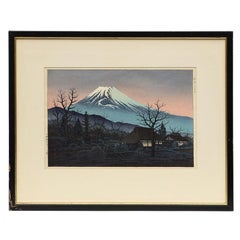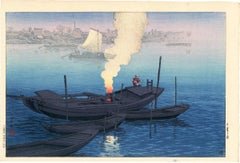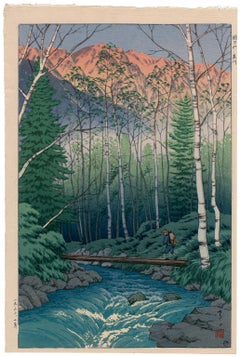Ito Takashi
Ito Takashi Landscape Woodblock Print, "Mt. Fuji from Susono", Signed
Located in New York, NY
Ito Takashi Landscape Woodblock: Mt. Fuji from Susono. Beautiful Japanese woodblock with good
Category
Vintage 1950s Japanese Mid-Century Modern Prints
Materials
Paper
$900 Sale Price
60% Off
H 16 in W 20 in D 1 in
Recent Sales
Ferry at Odai, Tokyo
By Ito Takashi
Located in Burbank, CA
thirties. It is unusual to find works by this artist bearing these early Watanabe seals. Signed: Takashi
Category
1930s Showa Landscape Prints
Materials
Mulberry Paper, Woodcut
Akeyuku Takegawa (Takegawa River at Dawn) — Japanese woodblock print
By Ito Takashi
Located in Myrtle Beach, SC
.
Literature: 'Ito Takashi Woodblock Prints Exhibition—Nostalgic Scenes', exhibition catalog, Natsukashii Fukei
Category
1930s Showa Landscape Prints
Materials
Woodcut
Akeyuku Takegawa (Takegawa River at Dawn)
By Ito Takashi
Located in Myrtle Beach, SC
Toledo Museum of Art
Ito Takashi studied and graduated from both the Kyoto School of Design and the
Category
1930s Showa Landscape Prints
Materials
Woodcut
People Also Browsed
Original Japanese Woodblock Print by Japanese Artist 19th Century
Located in Auribeau sur Siagne, FR
Rare, original 19th century woodblock print. Beautiful Edo period print from the original publisher. Quality framed with conservation glass in an black painted frame.
Red Blue Gree...
Category
Antique 19th Century Japanese Chinese Export Prints
Materials
Paper
$253 Sale Price
20% Off
H 16.15 in W 13 in D 0.79 in
Willem De Kooning Complete Set of 17 Lithographs Each Signed and Numbered 1988
By Willem de Kooning
Located in New York, NY
Seventeen Lithographs for Frank O'Hara, New York, Limited Editions Club, 1988 the complete set of 17 signed and numbered lithographs in colors by Willem De Kooning, title page, and j...
Category
Vintage 1980s American Modern Prints
Materials
Wood, Paper
$55,000 / set
H 28 in W 24.5 in D 1.5 in
Hiroshi Yoshida Signed & Sealed Framed Japanese Woodblock Print Sarusawa Pond
By Hiroshi Yoshida
Located in Studio City, CA
A wonderful image titled "Sarusawa Pond (Sarusawa ike)" by one of Japan's finest 20th-century artists and one of, if not the greatest working artist in the Shin-Hanga movement. Yoshi...
Category
Vintage 1930s Japanese Showa Prints
Materials
Wood, Paper
$1,245
H 18 in W 13 in D 1.5 in
Set of Four Late 19th Century French Architectural Engravings of Shopfronts
Located in Gloucestershire, GB
Fantastic set of four French late 19th Century architectural engravings.
These unusual and highly decorative engravings are of architectural drawings of shopfront/façade designs. ...
Category
Antique Late 19th Century French Country Prints
Materials
Glass, Giltwood
$3,127 / set
H 22.25 in W 17.33 in D 0.79 in
Utagawa Ando Hiroshige Japanese Woodblock Print Kinryuzan Temple, Asakusa
By Utagawa Hiroshige (Ando Hiroshige)
Located in Studio City, CA
A wonderful Japanese woodblock print by famed Japanese artist Utagawa Hiroshige (Ando Hiroshige) (1797-1858) titled "Kinryuzan Temple, Asakusa" was initially conceived in 1856. It i...
Category
20th Century Japanese Edo Prints
Materials
Paper
$695
H 14.5 in W 9.5 in D 0.1 in
Antique Framed Japanese Shunga Woodblock Print of a Man and a Woman Making Love
Located in Yonkers, NY
An antique Japanese Shunga woodblock print in gilt frame depicting a man and a woman making love. Created in Japan, this woodblock print called a Shunga and depicting a couple making...
Category
Antique 19th Century Japanese Prints
Materials
Glass, Wood, Paint
$1,200
H 16.5 in W 13.5 in D 1 in
Tadashi Nakayama Signed Limited Edition Japanese Woodblock Print Two Horses 1963
By Tadashi Nakayama
Located in Studio City, CA
This wonderfully designed, abstract work by esteemed Japanese printmaker Tadashi Nakayama. The print is pencil signed, numbered (13/80), dated 1963, stamped on the verso by the artis...
Category
Vintage 1960s Japanese Showa Prints
Materials
Paper
$1,495
H 25 in W 22.5 in D 1.5 in
Traditional Japanese Woodblock Print by Nishijima Katsuyuki
Located in Weesp, NL
Nishijima Katsuyuki (西島 勝之) is a contemporary Japanese artist known for his woodblock prints, which often depict traditional Japanese architecture and landscapes. Born in 1945 in Yam...
Category
1990s Japanese Mid-Century Modern Prints
Materials
Paper
Early Japanese Woodblock Print Kiyomizu-dera Temple in Kyoto by Kawase Hasui
By Kawase Hasui 1
Located in Atlanta, GA
An early edition Japanese woodblock print "Kiyomizu-dera Temple in Kyoto by Kawase Hasui (1883-1957) from the series Collected Views of Japan II, Kansai Edition (Nihon fukei shu II K...
Category
Vintage 1930s Japanese Showa Prints
Materials
Paper
$6,000
H 15.25 in W 10.25 in D 0.1 in
Authentic Japanese Woodblock Print by Kawase Hasui - Kiyomizu Temple in Kyoto
Located in Norton, MA
Description
Kawase Hasui - Kiyomizu Temple in Kyoto, woodblock, 1933, published by The S. Watanabe Color Print Co., with the 7mm and Heisei seals, 15.25" x 10.25".
This item is in ex...
Category
Mid-20th Century Japanese Prints
Materials
Paper
$5,975
H 15 in W 10.25 in D 0.15 in
Authentic Japanese Wood Block Print Kikyo by Masao Ido 1989
Located in Weesp, NL
This authentic 1989 Japanese woodblock print titled "Kikyō" (Balloon Flower) by Masao Ido is a rare and exquisite piece that embodies the essence of eternal love, sincerity, and eleg...
Category
Vintage 1980s Japanese Mid-Century Modern Prints
Materials
Paper
Kameyama Clear Weather after Snow Japanese Woodblock Print by Utagawa Hiroshige
By Utagawa Hiroshige (Ando Hiroshige)
Located in Tustin, CA
Kameyama is one of only two snow scenes in the Fifty-three Stations of thevTōkaidō Road series, and is greatly admired. It portrays a bright, clear day following a snowfall. Blue sha...
Category
Antique 19th Century Japanese Japonisme Prints
Materials
Paper
$975
H 14.5 in W 18.75 in D 0.5 in
Art Deco to MCM Green Bucket or Barrel Style Accent or Lounge Chairs a Pair
Located in Topeka, KS
Fabulous Mid-20th Century Art Deco to Mid-Century Modern bucket or barrel style accent or lounge chairs wearing their original green fabric with button detail on backs, jute strappin...
Category
Mid-20th Century Unknown Art Deco Lounge Chairs
Materials
Fabric, Jute, Wood
$2,995 / set
H 27 in W 31 in D 32 in
"Green Farming" Japanese Landscape Woodblock Print
By Toshi Yoshida 1
Located in Austin, TX
Japanese woodblock print (etching) of a landscape by Toshi Yoshida
11" x 15" - Page Size
17 x 21.25 - Frame Size
Category
20th Century Landscape Prints
Materials
Etching
Japanese Two Panel Screen: Antique Kimono Fabric Mounted on Screen
Located in Hudson, NY
Japanese Two Panel Screen: Late Nineteenth Century Kimono Fabric Mounted on Early Twentieth Century Screen. In the Heian period (eighth century to the twelfth century), noblemen wou...
Category
Early 20th Century Japanese Meiji Paintings and Screens
Materials
Silk, Wood, Paper
$17,200
H 67.75 in W 74.5 in D 1 in
Ando Utagawa Hiroshige Japanese Woodblock Print Mallard Duck
Located in Bridgeport, CT
Woodblock print depicting a mallard duck beneath the reeds surmounted on paper.. Presented in a wood frame with fine beading, matted and glazed.
Black calligraphy inscription upper l...
Category
Mid-20th Century Asian Meiji Prints
Materials
Glass, Wood, Paper
Get Updated with New Arrivals
Save "Ito Takashi", and we’ll notify you when there are new listings in this category.
More Ways To Browse
Futura Bar
Gail Markiewicz
Galos Porcelain
Garden Sculptures Faces
Garden Water Features
Garofano Faenza
Ge 265
General Electric Radio
Geoffrey Dashwood
Georg Jensen Coaster
Georg Jensen Magnolia
Georg Jensen Silver Coaster
Georg Jensen Sterling Cups
Georg Jensen Tea Strainer
Georg Thylstrup
George Cartlidge
George Ii Waiter
George Iii Chest Pair


